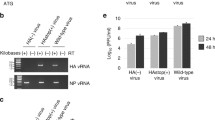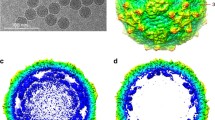Summary
A 6008 base pair fragment of the vaccinia virus DNA containing the gene for the precursor of the major core protein 4 a, which has been designated P4 a, was sequenced. A long open reading frame (ORF) encoding a protein of molecular weight 102,157 started close to the position where the P4 a mRNA had been mapped. Analysis of the mRNA by S1 nuclease mapping and primer extension indicated that the 5′ end defined by the former method is not the true 5′ end. This suggests that the P4 a coding region is preceded by leader sequences that are not derived from the immediate vicinity of the gene, similar to what has been reported for another late vaccinia virus mRNA. The sequenced DNA contained several further ORFs on the same, or opposite DNA strand, providing further evidence for the close spacing of protein-coding sequences in the viral genome.
Similar content being viewed by others
References
Barnes WM, Bevan M (1983) Kilo-sequencing: an ordered strategy for rapid DNA sequence data acquisition. Nucleic Acids Res 11: 349–368
Bertholet C, Drillien R, Wittek R (1985) One hundred base pairs of 5′ flanking sequence of a vaccinia virus late gene are sufficient to temporally regulate late transcription. Proc Natl Acad Sci USA 82: 2096–2100
Bertholet C, Van Meir E, ten Heggeler-Bordier B, Wittek R (1987) Vaccinia virus produces late mRNAs by discontinuous synthesis. Cell 50: 153–162
Essani K, Dales S (1979) Biogenesis of vaccinia: evidence for more than 100 polypeptides in the virion. Virology 95: 385–394
Henikoff S (1984) Unidirectional digestion with exonuclease III creates targeted break-point for DNA sequencing. Gene 28: 351–359
Katz E, Moss B (1970) Formation of a vaccinia virus structural polypeptide from a higher molecular weight precursor: inhibition by rifampicin. Proc Natl Acad Sci USA 66: 677–684
Maniatis T, Fritsch EF, Sambrook J (1982) Molecular cloning: a laboratory manual. Cold Spring Harbor Laboratory, New York
Maxam AM, Gilbert W (1977) A new method for sequencing DNA. Proc Natl Acad Sci USA 74: 560–564
Moss B, Rosenblum EN (1973) Protein cleavage and poxvirus morphogenesis: tryptic peptide analysis of core precursors accumulated by blocking assembly with rifampicin. J Mol Biol 81: 267–269
Moss B (1985) Replication of poxviruses. In: Fields BN, Chanock RM, Roizman B (eds) Virology. Raven Press, New York, pp 685–703
Niles EG, Condit RC, Caro P, Davidson K, Matusick L, Seto J (1986) Nucleotide sequence and genetic map of the 16-kb vaccinia virus HindIII D fragment. Virology 153: 96–112
Plucienniczak A, Schroeder E, Zettlmeissl G, Streeck RE (1985) Nucleotide sequence of a cluster of early and late genes in a conserved sequence of the virus genome. Nucleic Acids Res 13: 985–998
Rosel J, Moss B (1985) Transcriptional and translational mapping and nucleotide sequence analysis of a vaccinia virus gene encoding the precursor of the major core polypeptide 4 b. J Virol 56: 830–838
Rosel JL, Earl PL, Weir JP, Moss B (1986) Conserved TAAATG sequence at the transcriptional and translational initiation sites of vaccinia virus late genes deduced by structural and functional analysis of the HindIII H genome fragment. J Virol 60: 436–449
Sahli R, McMaster GK, Hirt B (1985) DNA sequence comparison between two tissue-specific variants of the autonomous parvovirus, minute virus of mice. Nucleic Acids Res 13: 3617–3633
Sanger F, Nicklen S, Coulson AR (1977) DNA sequencing with chain-terminating inhibitors. Proc Natl Acad Sci USA 74: 5463–5467
Sarov I, Joklik WK (1972) Studies on the nature and location of the capsid polypeptides of vaccinia virions. Virology 50: 579–592
Schwer B, Visca P, Vos JC, Stunnenberg HG (1987) Discontinuous transcription or RNA processing of vaccinia virus late messengers results in a 5′ poly(A) leader. Cell 50: 163–169
Weinrich SL, Hruby DE (1986) A tandemly-oriented late gene cluster within the vaccinia virus genome. Nucleic Acids Res: 14, 3003–3016
Weir JP, Moss B (1984) Regulation of expression and nucleotide sequence of a late vaccinia virus gene. J Virol 51: 662–669
Wittek R, Hänggi M, Hiller G (1984) Mapping of a gene coding for a major late structural polypeptide on the vaccinia virus genome. J Virol 49: 371–378
Wittek R, Richner B, Hiller G (1984) Mapping of the genes coding for the two major vaccinia virus core polypeptides. Nucleic Acids Res 12: 4835–4848
Author information
Authors and Affiliations
Rights and permissions
About this article
Cite this article
Van Meir, E., Wittek, R. Fine structure of the vaccinia virus gene encoding the precursor of the major core protein 4 a. Archives of Virology 102, 19–27 (1988). https://doi.org/10.1007/BF01315559
Received:
Accepted:
Issue Date:
DOI: https://doi.org/10.1007/BF01315559




